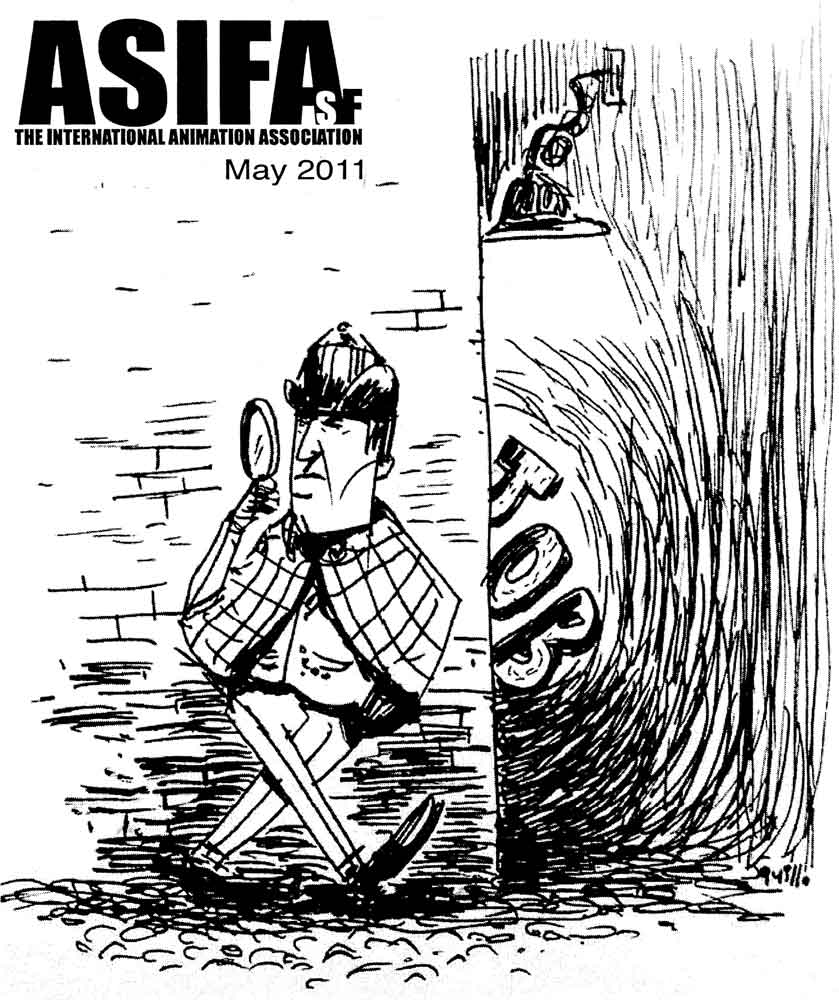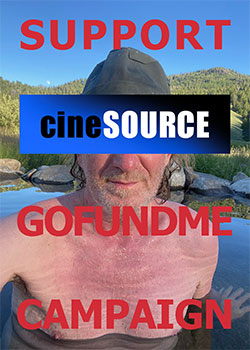Straight Dope on the Animation Biz
by Karl Cohen
Not so long ago, for-profit art schools were, and probably still are, painting glowing pictures of wonderful, high paying careers in animation, jobs with enormous salaries that will let you pay off your college loans and let you buy a dream car or even house right away. Such jobs do exist for top directors and animators with years of experience, BUT…
At ASIFA-San Francisco’s Careers in Animation event in March (ASIFA is the international animation association and full disclosure, this author is the chapter's president), the panel presented a pragmatic look at what one might expect after graduating in animation. While there are entry level openings at major studios, they are very selective, picking the best candidates in the country for relatively few openings.
Today, many of jobs are not permanent staff positions. When the project ends, there may be a period of unemployment until the company or someone else hires you for your next job. The audience was advised that a young professional working from project to project today needs to be flexible in what kind of work they are willing to do and where they will do it. The prima donna that only wants to animate using Maya may have a much rougher time finding a job than someone willing to work in other positions.
Each panel member talked about learning many different skills on the job which allowed them to get to where they are today. The employee that is willing to try to do different things and has a great attitude about being flexible is to be admired and will probably get hired a lot faster than somebody with an “attitude.”
Realistically your first jobs may be small ones helping out as an assistant on a production. Often the job leads will come from a friend you made in college or on a previous job. Each panel member stressed the importance of networking and creating a positive reputation that you are a good team worker and likable.
During the event the five guests mentioned how networking resulted in leads to jobs that led them in new directions. Those leads resulted in career changes that contributed to their being where they are today. Grady Sain, an art director with Obscura Digital had never heard of the type of company and work he now creates when a friend told him there was an opening in that company. The firm produces many things including spectacular visual events using projected digital images, often using several extremely bright projectors.
Use professional networking sites like LinkedIn to network and to keep in touch with friends. Gaining visibility and making new contacts is important. Also try to keep your website up to date and show only your best work on your website and in your sample reels. People who might hire you have probably seen dozens or perhaps hundreds of excellent reels so wow them with great stuff.
Tiffany Feeney, an Outreach Supervisor from PDI/DreamWorks said the two most exceptional reels she has seen recently were extremely short, highly original works. One was a film about a minute long was called “Crumpled Dreams” from CSU-Long Beach and the other was “No Robots” from San Jose State. They not only showed strong technical abilities, but also the ability to direct and write.
To really impress Tiffany show her original looking work, not just well executed student exercises or work that shows you are a big fan of anime or MTV. Her company already has a library of over 30,000 demo reels that have been submitted to them. The archive also includes evaluation notes about each reel. Tiffany suggests that if you really want to work for PDI/DreamWorks that you keep in touch by submitting your updated reel if it shows marked improvement. Don’t bug them every time you do more of the same; try to blow them away with something that stands out.
At PDI/DreamWorks they select their potential candidates for entry level jobs through on-campus recruitment events at approximately 40+ universities they feel have strong programs that stress both the technical and creative sides of animation. About 300 entry-level employees have been hired at DreamWorks Animation through the Outreach Program since its inception in 2004.
The Changing Job Markets for Animators
Running a studio is a rough business and people need to make career changes to survive in these difficult times. Carl Willat, who downsized Carl’s Fine Films a few years ago, says he is doing less work, but making as much money without the overhead of a midsized studio. Scott Kravitz, one of Carl’s former CG animators now works freelance in the LA area as a stop-motion animator (TV commercials for United Airlines and other companies) and in Vancouver, Canada as a CG animator (features including “Hop”).
One of the unfortunate changes in the Bay Area is the demise of several mid-sized companies including The Orphanage, WildBrain and ImageMovers Digital. When established companies like WildBrain break up, people have been able to find work, but not necessarily in similar situations. John Hays, who was once president of WildBrain is now an independent director. He directed about 20-minutes of excellent animation for “Howl” using a studio in Thailand and he just finished directing a short animated dream sequence for “Darling Companion,” a live action film written and directed by Lawrence Kasdan.
George Evelyn, who was a staff director at WildBrain is working at a studio in SW England on a TV series for Disney. Two other former members of the company are working with an advertising agency in Marin County that creates animated local and regional TV commercials. I just interviewed Colin Miller at Obscura Digital who had worked for WildBrain. He never expected he would ever create animation projected on the interiors and facades of major buildings including the Guggenheim Museum in NYC and the Sydney Opera House in Australia.
One of the purposes of our recent Careers in Animation event was to introduce the audience to some of the new employers and to the less well known ways people make a living in animation. Lots of other Bay Area animators are now employed outside of the well known companies located here.
Martin Meunier has recently opened a large studio in San Francisco that fabricates stop-motion puppets, builds sets and has filmed national TV commercials. He is presently doing preproduction work on a feature that will be directed by Henry Selick when it gets the “green light.” His past feature credits include “Coraline,” “The Life Aquatic with Steve Zissou,” “Monkey Bone,” “James and the Giant Peach” and “Starship Troopers.”
Tara Packard is the art director and head animator for Real Life Plus, a start up company “creating the next generation of casual games and social experiences.” When she graduated from Rhode Island School of Design she never expected she would ever work in animation. She was designing business cards when she got a chance to animate something. After several animation jobs she was offered a chance to work on a game. It never occurred to her to work on games, but it turned out she loved the challenge. Eventually she animated well-known games for Electronic Arts and other less well known titles for smaller companies.
Charlie Canfield was working in a Seattle film lab before he moved to San Francisco to work at ILM as a FX animator and motion control camera operator. His ILM credits include “The Rocketeer,” “Back To The Future” #2 & 3, Kurosawa's “Dreams,” “The Doors,” “Ghost,” and “The Hunt For Red October.” He then worked on national commercials and other projects at Colossal Pictures and WildBrain before becoming a freelance animator. His recent credits include Emmy Awards for animation on two documentaries and gold and silver awards at other festivals. He just finished four online ads for Google. Charlie mentioned that it has been years since he has had to send out resumes. His reputation and website gets him work.
Grady Sain’s most recent credit was Technical Director for the YouTube Symphony Orchestra event in March in Sydney, Australia. It was seen live on the Internet by millions of viewers. He directed all the amazing visuals projected on the outside of the Sydney Opera House. They included animation, motion graphics and live footage of the concert being performed inside. He has a traditional animation background that includes running his own studio on the East Coast before moving west.
Tiffany Feeney got her BFA in computer animation from Pratt and then a graduate degree in Design Management. Before coming to California she taught college and provided recruitment services for major animation and production houses in NYU. At PDI/DreamWorks she works as their Outreach Supervisor, working with a team that concentrates on university relations, college level recruiting as well as community related initiatives.
Your Job Search
A recent directory of schools offering animation programs in the US suggests there are thousands of people studying animation at this moment in time. The job market in animation has become highly competitive for the relatively few entry level jobs available so sample reels and/or portfolios have got to stand out. If they are not exceptional when you graduate keep improving them until they are.
If you dreamed as a teenager of becoming the next great Disney animator; that may never happen, but the animation industry is growing in the US in several other directions. While a few new faces are invited to join Pixar, Disney and DreamWorks each year, a lot more jobs are available in other facets of the animation industry. The game industry in 2004 in the US was grossing about $10.3 billion, in 2009 it was worth about $46.5 billion, and a recent trade paper thought the industry would be grossing about $65 billion in 2013. Their biggest area of growth is creating games for people who do not own video game machines. They play social networking games on hand held devices, laptops and on desktop computers. Right now that market expanding rapidly.
Animation on the Internet is another area of growth that is expanding. As commercial websites become more sophisticated more advertising, factual and entertainment shorts with decent quality animation will be needed. TV continues to consume a good deal of animation; however, budgets are often too low to support decent quality artwork. Hopefully TV networks will need more and better quality animation to compete for better ratings and advertising dollars.
Although not a big market at present, documentary films are finding animation useful when no live action footage is available for certain sequences. Animation is also incorporated into some pinball machines and slot machines (gambling devices) to keep players excited and busy dropping coins into the slots. There are also a wide range of animated films made that are rarely seen by the public including medical films and films used during trials to illustrate how something happened.
If you are planning to become a professional animator it may be a lot of work getting started, but hopefully you will enjoy being challenged by lots of creative problems as your career progresses and you will find it to be satisfying work and financially rewarding.
Karl Cohen is a writer and educator who specializes in animation and heads the local chapter of the International Animation Association. Posted on May 03, 2011 - 02:51 AM
by Karl Cohen
Not so long ago, for-profit art schools were, and probably still are, painting glowing pictures of wonderful, high paying careers in animation, jobs with enormous salaries that will let you pay off your college loans and let you buy a dream car or even house right away. Such jobs do exist for top directors and animators with years of experience, BUT…
At ASIFA-San Francisco’s Careers in Animation event in March (ASIFA is the international animation association and full disclosure, this author is the chapter's president), the panel presented a pragmatic look at what one might expect after graduating in animation. While there are entry level openings at major studios, they are very selective, picking the best candidates in the country for relatively few openings.
Today, many of jobs are not permanent staff positions. When the project ends, there may be a period of unemployment until the company or someone else hires you for your next job. The audience was advised that a young professional working from project to project today needs to be flexible in what kind of work they are willing to do and where they will do it. The prima donna that only wants to animate using Maya may have a much rougher time finding a job than someone willing to work in other positions.
Each panel member talked about learning many different skills on the job which allowed them to get to where they are today. The employee that is willing to try to do different things and has a great attitude about being flexible is to be admired and will probably get hired a lot faster than somebody with an “attitude.”
Realistically your first jobs may be small ones helping out as an assistant on a production. Often the job leads will come from a friend you made in college or on a previous job. Each panel member stressed the importance of networking and creating a positive reputation that you are a good team worker and likable.
During the event the five guests mentioned how networking resulted in leads to jobs that led them in new directions. Those leads resulted in career changes that contributed to their being where they are today. Grady Sain, an art director with Obscura Digital had never heard of the type of company and work he now creates when a friend told him there was an opening in that company. The firm produces many things including spectacular visual events using projected digital images, often using several extremely bright projectors.
Use professional networking sites like LinkedIn to network and to keep in touch with friends. Gaining visibility and making new contacts is important. Also try to keep your website up to date and show only your best work on your website and in your sample reels. People who might hire you have probably seen dozens or perhaps hundreds of excellent reels so wow them with great stuff.
Tiffany Feeney, an Outreach Supervisor from PDI/DreamWorks said the two most exceptional reels she has seen recently were extremely short, highly original works. One was a film about a minute long was called “Crumpled Dreams” from CSU-Long Beach and the other was “No Robots” from San Jose State. They not only showed strong technical abilities, but also the ability to direct and write.
To really impress Tiffany show her original looking work, not just well executed student exercises or work that shows you are a big fan of anime or MTV. Her company already has a library of over 30,000 demo reels that have been submitted to them. The archive also includes evaluation notes about each reel. Tiffany suggests that if you really want to work for PDI/DreamWorks that you keep in touch by submitting your updated reel if it shows marked improvement. Don’t bug them every time you do more of the same; try to blow them away with something that stands out.
At PDI/DreamWorks they select their potential candidates for entry level jobs through on-campus recruitment events at approximately 40+ universities they feel have strong programs that stress both the technical and creative sides of animation. About 300 entry-level employees have been hired at DreamWorks Animation through the Outreach Program since its inception in 2004.
The Changing Job Markets for Animators
Running a studio is a rough business and people need to make career changes to survive in these difficult times. Carl Willat, who downsized Carl’s Fine Films a few years ago, says he is doing less work, but making as much money without the overhead of a midsized studio. Scott Kravitz, one of Carl’s former CG animators now works freelance in the LA area as a stop-motion animator (TV commercials for United Airlines and other companies) and in Vancouver, Canada as a CG animator (features including “Hop”).
One of the unfortunate changes in the Bay Area is the demise of several mid-sized companies including The Orphanage, WildBrain and ImageMovers Digital. When established companies like WildBrain break up, people have been able to find work, but not necessarily in similar situations. John Hays, who was once president of WildBrain is now an independent director. He directed about 20-minutes of excellent animation for “Howl” using a studio in Thailand and he just finished directing a short animated dream sequence for “Darling Companion,” a live action film written and directed by Lawrence Kasdan.
George Evelyn, who was a staff director at WildBrain is working at a studio in SW England on a TV series for Disney. Two other former members of the company are working with an advertising agency in Marin County that creates animated local and regional TV commercials. I just interviewed Colin Miller at Obscura Digital who had worked for WildBrain. He never expected he would ever create animation projected on the interiors and facades of major buildings including the Guggenheim Museum in NYC and the Sydney Opera House in Australia.
One of the purposes of our recent Careers in Animation event was to introduce the audience to some of the new employers and to the less well known ways people make a living in animation. Lots of other Bay Area animators are now employed outside of the well known companies located here.
Martin Meunier has recently opened a large studio in San Francisco that fabricates stop-motion puppets, builds sets and has filmed national TV commercials. He is presently doing preproduction work on a feature that will be directed by Henry Selick when it gets the “green light.” His past feature credits include “Coraline,” “The Life Aquatic with Steve Zissou,” “Monkey Bone,” “James and the Giant Peach” and “Starship Troopers.”
Tara Packard is the art director and head animator for Real Life Plus, a start up company “creating the next generation of casual games and social experiences.” When she graduated from Rhode Island School of Design she never expected she would ever work in animation. She was designing business cards when she got a chance to animate something. After several animation jobs she was offered a chance to work on a game. It never occurred to her to work on games, but it turned out she loved the challenge. Eventually she animated well-known games for Electronic Arts and other less well known titles for smaller companies.
Charlie Canfield was working in a Seattle film lab before he moved to San Francisco to work at ILM as a FX animator and motion control camera operator. His ILM credits include “The Rocketeer,” “Back To The Future” #2 & 3, Kurosawa's “Dreams,” “The Doors,” “Ghost,” and “The Hunt For Red October.” He then worked on national commercials and other projects at Colossal Pictures and WildBrain before becoming a freelance animator. His recent credits include Emmy Awards for animation on two documentaries and gold and silver awards at other festivals. He just finished four online ads for Google. Charlie mentioned that it has been years since he has had to send out resumes. His reputation and website gets him work.
Grady Sain’s most recent credit was Technical Director for the YouTube Symphony Orchestra event in March in Sydney, Australia. It was seen live on the Internet by millions of viewers. He directed all the amazing visuals projected on the outside of the Sydney Opera House. They included animation, motion graphics and live footage of the concert being performed inside. He has a traditional animation background that includes running his own studio on the East Coast before moving west.
Tiffany Feeney got her BFA in computer animation from Pratt and then a graduate degree in Design Management. Before coming to California she taught college and provided recruitment services for major animation and production houses in NYU. At PDI/DreamWorks she works as their Outreach Supervisor, working with a team that concentrates on university relations, college level recruiting as well as community related initiatives.
Your Job Search
A recent directory of schools offering animation programs in the US suggests there are thousands of people studying animation at this moment in time. The job market in animation has become highly competitive for the relatively few entry level jobs available so sample reels and/or portfolios have got to stand out. If they are not exceptional when you graduate keep improving them until they are.
If you dreamed as a teenager of becoming the next great Disney animator; that may never happen, but the animation industry is growing in the US in several other directions. While a few new faces are invited to join Pixar, Disney and DreamWorks each year, a lot more jobs are available in other facets of the animation industry. The game industry in 2004 in the US was grossing about $10.3 billion, in 2009 it was worth about $46.5 billion, and a recent trade paper thought the industry would be grossing about $65 billion in 2013. Their biggest area of growth is creating games for people who do not own video game machines. They play social networking games on hand held devices, laptops and on desktop computers. Right now that market expanding rapidly.
Animation on the Internet is another area of growth that is expanding. As commercial websites become more sophisticated more advertising, factual and entertainment shorts with decent quality animation will be needed. TV continues to consume a good deal of animation; however, budgets are often too low to support decent quality artwork. Hopefully TV networks will need more and better quality animation to compete for better ratings and advertising dollars.
Although not a big market at present, documentary films are finding animation useful when no live action footage is available for certain sequences. Animation is also incorporated into some pinball machines and slot machines (gambling devices) to keep players excited and busy dropping coins into the slots. There are also a wide range of animated films made that are rarely seen by the public including medical films and films used during trials to illustrate how something happened.
If you are planning to become a professional animator it may be a lot of work getting started, but hopefully you will enjoy being challenged by lots of creative problems as your career progresses and you will find it to be satisfying work and financially rewarding.
Karl Cohen is a writer and educator who specializes in animation and heads the local chapter of the International Animation Association. Posted on May 03, 2011 - 02:51 AM
























